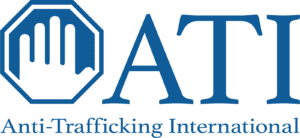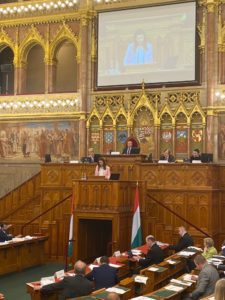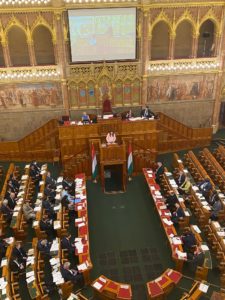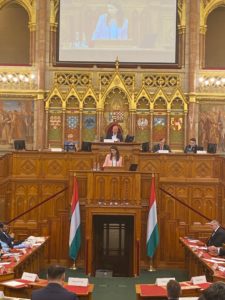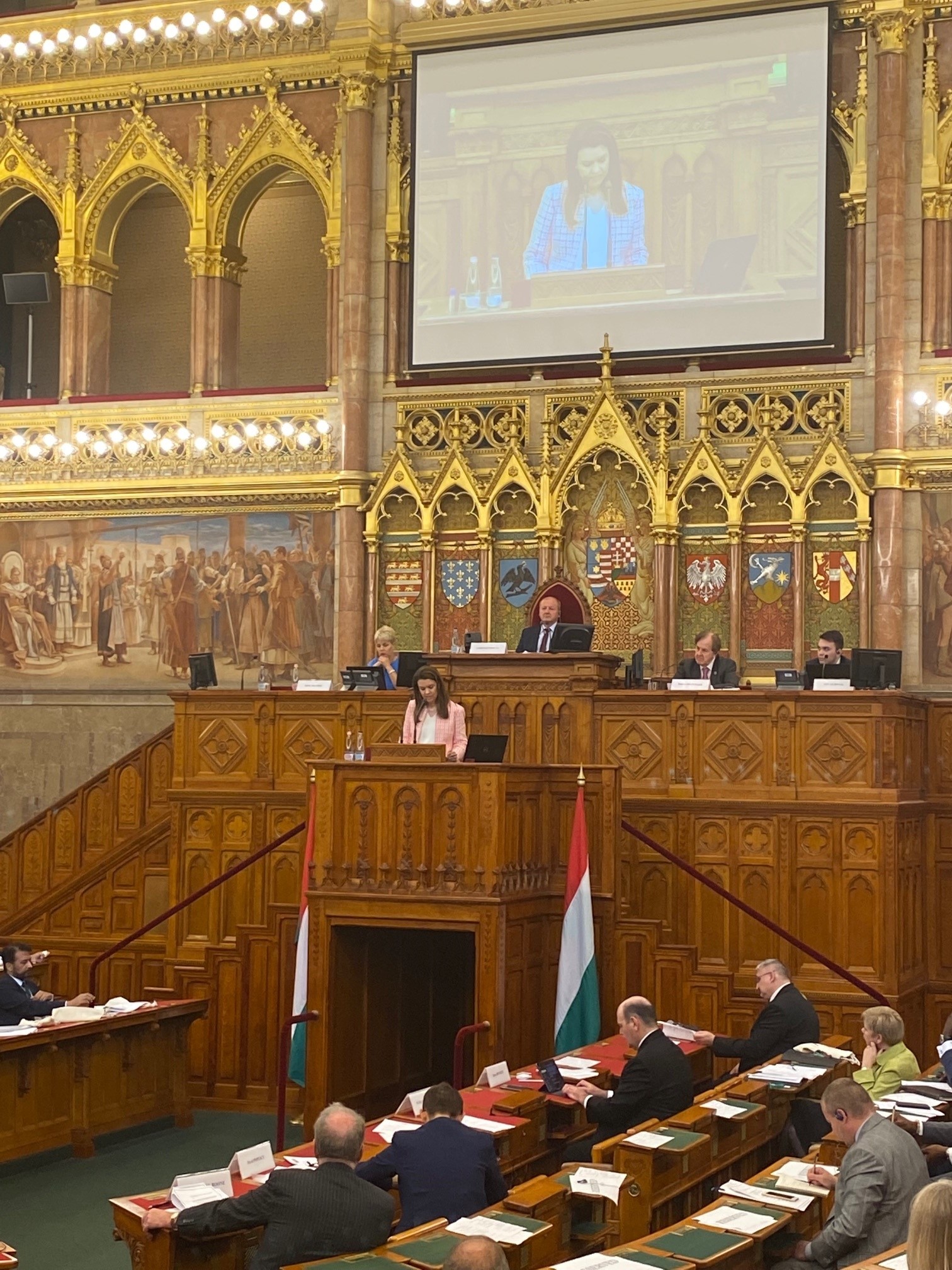
“Human Trafficking and Illicit Financing” – ATI’s CEO Remarks at the September 6 Parliamentary Intelligence-Security Forum
As chair of the Parliamentary Intelligence-Security Forum’s (PI-SF) Human Trafficking Task Force, Anti-Trafficking International’s (ATI) Chief Executive Officer, Anne Basham, addressed the PI-SF at their conference held in Budapest, Hungary. View her remarks below and our related press release for more information.
Human Trafficking and Illicit Financing
- Congressman Pittenger, Members of Parliament, and Ambassadors: thank you so much for inviting me to be a part of this.
- I’m thankful for the forum today to address this critical intersection between human trafficking and illicit finance.
- Let me start with the story of Leila. Leila was a 12-year-old Yazidi girl in Iraq in 2014 when ISIS terrorists attacked her village. Like thousands of girls, she was rounded up with her family, and the women and girls were separated from the men and boys. She was taken to an underground facility with approximately fifty other girls where she was kept for two years with no sunlight and sold for sex to men every day until the age of 14 when her health was in such poor condition that she was deemed no longer useful to ISIS. Eventually, ISIS fighters contacted her family and offered to return her for ransom, which they did. She is alive physically, but emotionally she will never recover. The funds from selling Leila and others were used to fuel ISIS terrorist operations which threatened not only the stability of the Middle East, but potentially the world.
- This is why human trafficking should be viewed as not only a humanitarian issue but also a national security issue—it funds the very terrorists who threaten our freedoms and safety.
- Leila is an example of human trafficking—a form of modern-day slavery—and it occurs when a human being is treated not as a person but as a commodity to be sold and eventually discarded. Human trafficking is compelling a person through force, fraud or coercion to engage in sex or labor, and it generates the U.S. equivalent to $150B annually worldwide for traffickers. The International Labour Organization estimates that there are 3 million people enslaved or victims of trafficking and institutional rape.
- Human trafficking is said to be the second largest criminal enterprise in the world, only surpassed by drug trafficking. However, there are many people who now believe that it has likely surpassed drug trafficking and arms sales internationally, but we just don’t have the data yet to show this.
- Why is this? What is fueling this epidemic? At the core is greed. Unlike drugs or weapons, a person can be sold more than once. In fact, when human beings are viewed as a product, they can be sold over and over again. The reality is that every 30 seconds a child or teen is sold into slavery, and only 1% of those victims are ever recovered.
- When most people think of human trafficking, they think of kidnapping. However, in the United States and many other countries, most often human trafficking occurs through the process of manipulation and grooming over a period of time. In the United States alone 1 in 5 children will be approached by a trafficker at some point in their lifetime.
- Like victims, traffickers come from all parts of society—every race, gender, and socio-economic group. So what do traffickers really look like? They often pose as a:
- Boyfriend or girlfriend. A common type is an attractive polished man or woman in their early 20s who pretends to be a girlfriend or boyfriend to the teen. Then systematically over time the victim’s trust is gained through gifts and flattery. Eventually, the victim is threatened or manipulated by threats of harm to themselves or their families into sexual encounters for profit to the trafficker.
- Traffickers also look like organized criminal networks such as gangs. Criminal networks play a significant role in trafficking, sometimes using associates with a less threatening appearance to make the initial approach.
- Traffickers sometimes pose as false employers to lure victims into both sex and labor trafficking with promises of modeling or other glamorous careers.
- Finally, some victims are trafficked by their own family members or foster parents.
- Who do traffickers target? Young people who:
- Lack a sense of belonging to others
- Base their self-worth on popularity or relationships
- Are willing to keep secrets, including their relationship
- Don’t have a good relationship with their parents
- Are looking for a boyfriend or girlfriend
- Are often bored
- Spend frequent time away from family and friends
- Are willing to take directions and believe the lies and false promises of the trafficker
- Those with pre-existing physical, emotional and cognitive disabilities which place them in an increased vulnerable state
- I know the statistics are grim, but I also know that there is a solution for almost everything, and human trafficking is no exception. I previously worked on combatting human trafficking and violence against women at the Department of Justice in Washington, D.C., where I saw firsthand the never-ending cycle of “rescue, restore, repeat.” I have talked to survivors of human trafficking from around the world and listened to their stories of how they became trapped and enslaved in a life they never imagined. That’s why as the CEO of Anti-Trafficking International, our goal is to see this cycle of violence eradicated and stopped completely all around the globe. So here’s how we can do this.
- First, when it comes to dismantling terrorist cells and warlords around the globe, how do terrorists fund their enterprises? Frequently through kidnapping and human trafficking. In fact, human trafficking is one of the primary sources of financing for terrorist groups like Boko Haram and ISIS. Boko Haram is also known as ISIS West Africa, and they have systematically targeted schools in Nigeria that are full of girls, kidnapped them, and sold them for money and as “child brides.” Boko Haram has financed their terrorist operations by selling kidnapped girls for sex.
- And how has ISIS fueled their operations in the Middle East? They raided Yazidi villages in Iraq, stole an entire generation of women and girls, put them in underground rooms where many of them never saw the light of day for years, and then sold them every day to men. Yazidi women and girls were sold to ISIS fighters for between $200–$1,500 a day, bringing in a significant source of income for the organization.
- So what can be done about this? The same thing that governments do when they want to dismantle instigators of war and mass violence: follow the money.
- Here in the United States, we have an incredible and innovative mechanism called Global Magnitsky sanctions. With Global Magnitsky sanctions, the U.S. can target warlords and terrorist leaders with economic sanctions and render them powerless by cutting off their supply of funding through large and small channels. The U.K. now also has a version of Magnitsky-style sanctions with their Sanctions and Anti-Money Laundering Act of 2018.
- If governmental leaders targeted rescuing and stopping the flow of human trafficking victims to terrorist operations around the world, this would be akin to significant sanctions on these evil operations.
- How do we determine which countries to target? The S. State Department’s Trafficking in Persons (TIP) Report is an important tool that ties U.S. foreign aid funding to a country’s human trafficking tier ranking in the report. Tier 3 is reserved for countries and territories whose governments do not fully comply with the minimum standards and are not making significant efforts to do so. As an example, Afghanistan was given the lowest ranking in the 2020 TIP Report for the second year in a row, and just remember this ranking came before the Taliban took over. According to U.S. law, the United States may seek to withhold financing to countries in this category, and they may be denied “non-humanitarian, non-trade assistance…” as an incentive to improve their rating.
- In fact, ATI has been working behind the scenes with legislators in the United States on the Frederick Douglass Trafficking Victims Protection Act of 2021 (or TVPA reauthorization) which will leverage trade status and other U.S. monies to ensure foreign countries are held accountable for their efforts—or lack thereof—to stop human trafficking. The bill also specifically calls severe forms of trafficking as a reason for Global Magnitsky sanctions.
- For example, if significant efforts were placed on trying to stop the flow of girls into the hands of Boko Haram and ISIS, they would lose a significant portion of their income, and ultimately the world would be a safer place. Focusing on rescuing and reducing the number of sex trafficking victims around the world is not only heroic, it is a highly effective form of sanctions itself against terrorist leaders. According to the United Nations, one in three women are affected by gender-based violence and this number skyrockets 200% in high conflict zones where terrorist cells thrive. The way to cut off the head of terrorism and human trafficking is similar: cut off the flow of money. Currently over 2,800 women and children are estimated to be experiencing ongoing sexual abuse in ISIS captivity alone. Imagine the crippling financial impact this would have on ISIS if they were suddenly all released. Prioritizing the rescue and prevention of human trafficking victims is a form of sanctions against terrorist cells.
- So how do we prevent and reduce the number of human trafficking victims? In a simple word: education. If you remember one thing today, I hope it is this: prevention education is key to the eradication of both terrorism and trafficking in the earliest stages of inception. Prevention education is going upstream from the problem and dismantling the ideas and deceptions that led to this in the first place.
- I have dedicated my personal and professional life to education and helping women and children escape from violence around the world, and I want to give you just one real-life example of how one prevents the other. There is a woman from a country in Africa who I will call Hazel. Hazel is like many young women in her country; she attended school, has a family who loves her, and was in the process of striving to achieve her dreams in life. She and others in her village were told about a great opportunity to be housekeepers for wealthy families in Europe. In search of financial independence and a new life, Hazel scraped together funds to fly herself to Europe to accept the job. Unfortunately, when she got off the plane she was in the Middle East, her passport was taken from her, and she was enslaved to a family where she was worked tirelessly, was raped repeatedly, and told she must pay off a debt she could never repay. I’ve spoken to this woman, Hazel, and heard from others like her, and unfortunately her story is typical. She is strong and resilient and she is desperate to go home and be free, but she has also told me that she wants to make sure that the other women in her home country are warned of the deceptions of human trafficking so that they didn’t suffer the same fate as her.
- In July of 2019, the Organization for Security and Cooperation in Europe (OSCE) passed a resolution recognizing our organization as one of only 3 global leaders in the development of human trafficking prevention curriculum internationally, but I’m here to tell you that there is still so much work for us to do. What if we fought the $1.5B spent globally each year on human trafficking with just $100M in targeted funding for preventative education worldwide?
- I’m well aware that the word education produces no adrenaline rush. Most people do not associate education with action, but widespread education to youth, law enforcement, parents, and financial professionals is the single greatest key to preventing this epidemic of entrapment, kidnapping, and violence. Widespread education globally is a destructive force to the human trafficking industry worldwide. This is why dictators place a priority on controlling the educational system in their country—because when you educate a child, you change the beliefs and attitudes of an entire generation. If a priority is placed on funding and implementing curricula for all children about the signs of grooming and human trafficking, as well as the importance of respect and equality, then victims would be less likely to be lured into labor or sex trafficking, and offenders would be less likely to become recruiters and traffickers themselves. If law enforcement in countries around the world were educated on how to spot the signs of human trafficking and encouraged to effectively respond and dismantle it, there would be fewer victims and fewer traffickers able to conduct their operations.
- We need to make it harder on the traffickers internationally to not only kidnap victims but also harder to recruit young people to join their ranks.
- Once traffickers have their money, they then implement money laundering tactics to move money quickly and anonymously across large geographic areas through interstate funnel account activity.
- In the United States, funnel account activity is when an associate of a criminal organization makes a series of small deposits under $10,000 which are not subject to reporting requirements, and the cash is then withdrawn in another state by a different associate of the criminal organization. These funnel accounts allow them to exploit the U.S. banking system by moving money quickly and cheaply across great distances.
- Because of this, banking institutions are on the frontlines of the war against human trafficking. Financial institution employees are among those most likely to see and report suspicious account activity or suspicious movement of proceeds, and they are often the first step in helping to rescue individuals from human trafficking.
- To address this, several major banks have enhanced internal controls that have disrupted criminal organizations’ ability to employ interstate funnel accounts to move their proceeds, but there is still much more to do. My challenge to financial institutions specifically is to increase their role in supporting these efforts through mandating “red flag” training to employees and coordinating with NGOs like ATI’s National Human Trafficking Intelligence Center to understand and implement practices that are responsive to this and also safeguard financial transactions. Banks have an obligation to adapt by integrating safeguards and accountability, and by encouraging employees to not only report suspicious transactions but also to look for them.
- If we really want to stop the epidemic of modern-day slavery, we need to defensively stop the flow of illicit funding for human trafficking, and offensively dedicate money to preventing human trafficking through widespread prevention education.
- This two-pronged approach will require a collaborative effort of public and private partnerships between governmental leaders, NGOs, and communities.
- Thank you.
